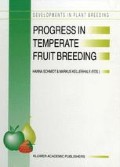Summary
Approximately 1000 seedlings from 20 combinations crossed in 1979, 1980 and 1981 (Theiler-Hedtrich 1985a) were tested for several characters: fruit set (yield), fruit size, fruit colour, formation of abscission layer and bleeding after fruit removal from fruit stalks, bacterial canker resistance, flowering and harvesting time. From progeny of crosses with Stella as pollinator, 56% (Vittoria × Stella) and 46% (Schüttler × Stella) of the seedlings were self-compatible, of which 14 were high yielding with good fruit size and quality. From the data recorded it can be concluded: fruit set is a recessive character; only 5 to 20% of very good yielding seedlings were obtained in different progeny, even if the parental plants were both very good croppers. Fruit juice and skin colour was in most progenies ‘black’ even if they were from combinations with ‘white’ varieties, e.g., Merton Glory or Schüttler. Only from the combination Schüttler (‘white’) × Stella (‘black’), 50% of the seedlings were ‘white’; Stella therefore is heterozygous for the character of fruit juice and skin colour. Fruit size is evenly distributed in progeny with respect to the fruit size of their parent plants. Abscission layer formation and non-bleeding is a genetically complex character. In combinations where both parent plants formed fruits with complete abscission layers and which were not bleeding after fruit removal from the stalk, this character was inherited only to 50% (Vittoria × Schüttler) or 85% (Vittoria × Frühe von der Weid) in the progeny. For the genetical control of this character further studies are necessary. Bacterial canker susceptibility was evenly distributed in seedlings from all combinations even if the highly resistant cv. Vittoria was used as one parent plant, thereby not confirming the expected results of a higher proportion of resistant seedlings from combinations with Vittoria. Flowering and harvest time of the seedlings from different combinations was within the range of the parent plants. Only in the combination of Vittoria ×. Stella (mid-to late-ripening season) one seedling out of 99 was found to form ripe fruits two weeks earlier than the parental plants. From the seedlings tested 40 have been chosen for further evaluation or genetical studies.
Access this chapter
Tax calculation will be finalised at checkout
Purchases are for personal use only
Preview
Unable to display preview. Download preview PDF.
References
Bargioni, G., 1970. ‘Vittoria’ nuova cultivar di ciliegio dolce. Rivista della Ortoflorofrutticoltura Italiano 6: 3–12.
Crane, M.B. & A.G. Brown, 1955. Incompatibility and varietal confusion in cherries. Scient. Hort. 11: 53.
Krapf, B., 1976. Die Befruchtungsverhältnisse der Obstbäume. Flugschrift Nr. 30 der Eidg. Forschungsanstalt Wädenswil.
Lapins, K.O., 1971. Stella a self fruitful sweet cherry. Can. J. Plant Sci. 51:252–253.
Matthews, P., 1973. Some recent advances in sweet cherry genetics and breeding. Proc. EUCARPIA Fruit Section Symp. 5. Topic Fruit Breeding. Canterbury: 84–107.
Matthews, P., 1979. Progress in breeding cherries for resistance to bacterial canker. EUCARPIA Fruit Section, Tree Fruit Breeding. Angers: 157–174.
Riesen W., T. Meli, W. Zbinden & A. Widmer, 1991. Regendach für Tafelkirschen. Schweiz. Zeitschrift für Obst-und Weinbau 127: 360–372.
Sansavini, S. & W.D. Lane, 1983. ’sunburst’ e ‘Lapins’ ciliege autofertili durone-simili. Frutticoltura 45: 55–57.
Schaer, E., 1977. Die Kirschensorte ‘Heidegger’ (eine Erstbeschreibung). Schweiz. Zeitschrift für Obst-und Weinbau 113: 389–392.
Theiler, R., 1971. Embryonenkultur für die Anzucht neuer Kirschenhybriden. Schweiz, landw. Forschung. X: 65–93.
Theiler-Hedtrich, R., 1985 a. Sweet cherry breeding programme at the Swiss Federal Research Station. I. Results of fruit characters and flowering period inheritance. Acta Horticulturae 169: 51–62.
Theiler-Hedtrich, R., 1985 b. Sweet cherry breeding programme at the Swiss Federal Research Station. II. Results of bacterial canker resistance and seedling vigour. Acta Horticulturae 169: 63–71.
Theiler-Hedtrich, R., 1990. Beziehung zwischen Fruchtgewicht und Fruchtbreite bei Kirschen. Schweiz. Zeitschrift für Obst-und Weinbau 126: 590–598.
Way, R.D., 1968. Pollen incompatibility groups of sweet cherry clones. Proc. Amer. Soc. Hort. Sci. 92: 119–123.
Author information
Authors and Affiliations
Editor information
Editors and Affiliations
Rights and permissions
Copyright information
© 1994 Springer Science+Business Media Dordrecht
About this chapter
Cite this chapter
Theiler-Hedtrich, R. (1994). Inheritance of tree and fruit characters in progenies from crosses of sweet cherry (Prunus avium L.) cultivars. In: Schmidt, H., Kellerhals, M. (eds) Progress in Temperate Fruit Breeding. Developments in Plant Breeding, vol 1. Springer, Dordrecht. https://doi.org/10.1007/978-94-011-0467-8_33
Download citation
DOI: https://doi.org/10.1007/978-94-011-0467-8_33
Publisher Name: Springer, Dordrecht
Print ISBN: 978-94-010-4209-3
Online ISBN: 978-94-011-0467-8
eBook Packages: Springer Book Archive

